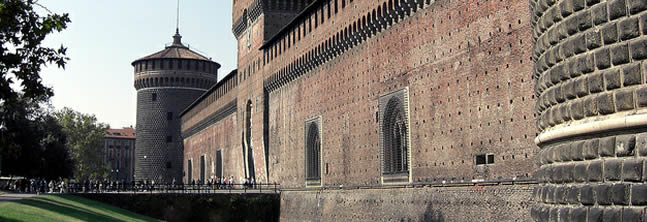The castle has an imposing and iconographic aspect which makes it one of Milan’s landmarks. During the Renaissance it was the residence of Milan’s Duke Ludovico Sforza. Leonardo worked there as a military and civil engineer and only later as an artist. He painted the frescoed ceiling of the "Sala delle Asse" (‘room of the wooden panels’), combining a naturalist depiction with a strong symbolism.
Watch our video about the Sforza Castle
The symbolism of ‘Sala delle Asse’
The canopy of entwined branches rises from 16 tree trunks along the walls, forming a thick vegetation that stretches across the ceiling and around the central coat of arms of Ludovico Sforza and his wife Beatrice d’Este. Leonardo was, however, an acute observer of nature and chose to paint a very precise type of tree, the mulberry. This plant was used to rear silkworms and silk was in fact a great economic resource for the Sforza Duchy. Ludovico Sforza was also known as ‘il Moro’, literally the mulberry and this may explain Leonardo’s choice. On the other hand the mulberry was also a symbol for prudence and it can therefore be a reference to the politics adopted by Ludovico Sforza to consolidate its state through careful alliances.
History of the Castle and collection highlights
The castle was founded in 1300's by Galeazzo II Visconti. Later demolished and rebuilt several times over the centuries, it was entirely reconstructed by Francesco Sforza in 1450s. The beautiful clock tower which makes the castle so easily recognizable in the city skyline was originally designed by to the Florentine architect Antonio Averlino – also known as Filarete (literally ‘lover of excellence) and rebuilt in 19th century by Luca Beltrami. The castle is still today beautifully preserved. It hosts a series of civic museums ranging from ancient and Egyptian art to paintings, musical instruments and 21st century furniture. The art gallery displays works by some famous Italian artists such as Mantegna, Giovanni Bellini e Antonello da Messina but the real masterpiece is the ‘Pietà Rondanini’, an unfinished sculpture by Michelangelo on which he worked in the last years of his life.
Did you know that?
The Sforza Castle houses another important work by Leonardo, the Codex Trivulzianus, a manuscript containing notes and drawings dealing mainly with military and religious architecture. This codex is housed in the Trivulziana library and is generally not on public display.



